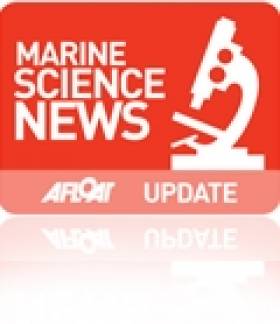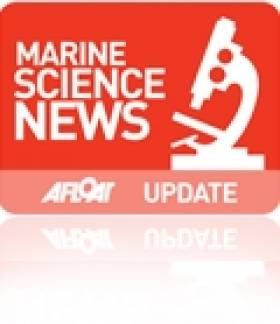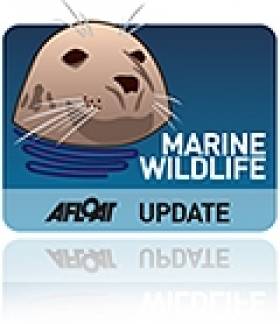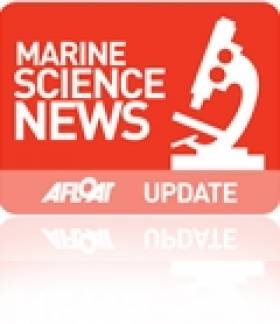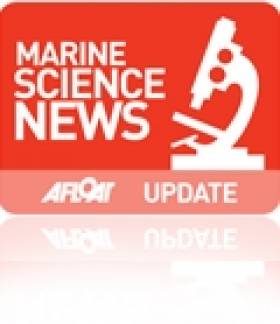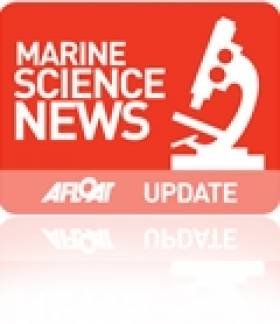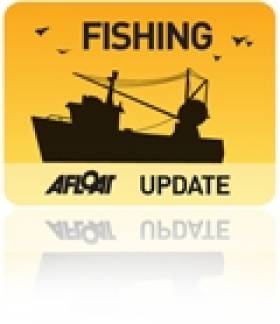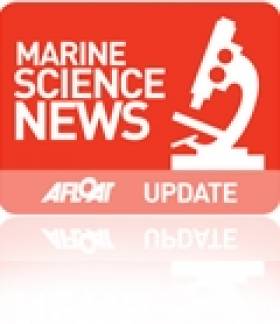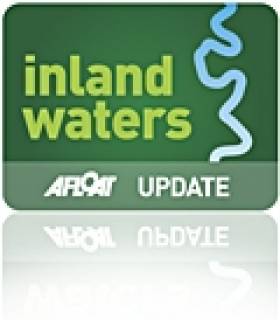Displaying items by tag: Marine Institute
U.S. Nobel Laureate Visits Marine Institute in Galway
The Marine Institute headquarters at Oranmore, Co. Galway was honoured last Saturday (6th November) by a visit from US Energy Secretary Prof. Steven Chu, himself a Nobel Prize-winning physicist and long-time advocate of alternative sources of sustainable energy.
This is the latest in a number of VIP visits to the Institute this year, which have included EU-Commissioner for Research, Innovation and Science Máire Geoghegan-Quinn and the Ambassadors to Ireland of both the USA and the United Kingdom, reflecting the growing international recognition of the Institute as a centre of excellence.
During his visit, Professor Chu was briefed by the Institute's CEO Dr Peter Heffernan and members of his senior management team on the Institute's work regarding ocean renewable energy, seabed observatories and the application of "Smart Technology" to ocean monitoring and climate change through such projects as SmartBay and SmartCoast.
He was also briefed on the results of the Irish National Seabed Survey which, at the time of its execution was the largest civilian mapping project in the world, and was given copies of "The Real Map of Ireland" showing the extent of Ireland's underwater territory.
Of particular interest to Prof. Chu, following the recent oil spill in the Gulf of Mexico, was a discussion on the use of new and developing technologies that might allow the deployment of sensor devices on the seabed to monitor offshore oil wells.
Galway Atlantaquaria Nets Second Education and Outreach Award
Galway Atlantaquaria who, with the Marine Institute, Forfas Discover Primary Science and others are partners in the Explorers marine education and outreach programme, have achieved their second prestigious award - Best Education Project : Public and General Visitor 2010 - from the Britain and Ireland Association of Zoos and Aquaria (BIAZA) for their marine education and outreach activities.
The award, was presented at Paignton Zoo Environmental Park, Devon by Adrian Sanders MP and was given for the "Galway Marine Month of Madness" event, organised by the Atlantaquaria with help from the other Explorers partners during the month of May this year.
Speaking for the Atlantaquaria, Marketing Executive Colette Lavin said that the award was a tribute not only to the Atlantaquaria but to all those involved in the month-long celebration. "A lot of people put a lot of heart and hard work into the individual events that made up the Month of Marine Madness," she said. "And while this second BIAZA award is the most tangible benefit of all this, I really believe that the biggest reward for all our efforts is the raised awareness of the value of our oceans and seas, not only to Galway, but to the rest of the country."
The calendar of events was launched by Galway's Deputy Mayor Mr. Peter Keane at Salthill beach and events arranged during the Month of Marine Madness ranged from seashore safaris, diving lessons, scientific lectures, nature walks and angling demonstrations, to a series of free seminars at the Atlantaquaria on such subjects as Baleen Whales, Slimy
Seaweed, the value of outdoor education, and Pirates! The First Entrepreneurs. A highlight of the calendar was the 'Largest Beach Clean Up in Ireland' which took place on Sunday 18th of May. Over 2,000 members of the public took part in the various events which included a tour of the national research vessel RV Celtic Explorer by 280 pupils from local primary schools.
Speaking for the Explorers Programme, Dr. John Joyce of the Marine Institute said that the effort put in by Colette and her team had raised awareness of the sea to a whole new level in Galway during the month of May. "While Explorers is targeted primarily at raising awareness of the sea in schools, Colette and the Galway Atlantaquaria have shown us how we can raise that awareness to a whole new level by reaching out into the wider community. Last year, the Volvo Ocean Race vividly demonstrated the value of the sea to Galway in terms of tourism revenue. Clearly, the way is open to build on that awareness
and to use our creativity in finding new ways that Galway can profit - financially, educationally and environmentally – from marine related events."
Galway Atlantaquaria, the Marine Institute and the other partners in the Explorers programme celebrated the launch of National Science Week on Sunday 7th November with a Sunday Funday entitled "Our Plaice in Space" to celebrate the connections between outer and inner space.
Later in the month, on November 21st, the Explorers Programme will be present at the Galway Science and Technology Festival in NUI Galway.
European Shark Experts Gather in Galway
International experts on sharks, skates and rays will meet at the Marine Institute in Galway for the 14th Annual European Elasmobranch* Association Conference from 10th-13th November 2010.
The waters around Ireland are home to a rich diversity of sharks, skates and rays, with over forty different species regularly recorded. Since 1997 the Irish Elasmobranch Group (IEG) has been promoting the research, conservation and awareness of these animals in Irish waters.
"Ireland is not alone in having a specific body dedicated to the promotion of shark research with many other European countries having similar groups," said conference organiser Dr. Edward Farrell who has spent the last four years studying Smooth Hound Sharks under the supervision of Dr. Stefano Mariani of the University College, Dublin and Dr. Maurice Clarke of the Marine Institute. The European Elasmobranch Association (EEA) is a share-holding organisation for coordinating the activities of all the national shark organisations dedicated to the study, management or conservation of sharks, skates and rays within Europe.
"Irish shark research will feature strongly at the conference," said Dr. Clarke, "with presentations on the satellite tagging of porbeagle sharks and a global population study of blue sharks among the highlights."
The conference this year will cover a wide variety of topics including elasmobranch taxonomy, biology, management and conservation, fisheries and ecology. It will also be preceded by a meeting of the Shark Specialist Group of the International Union for the Conservation of Nature (IUCN) on Tuesday 9th November in Galway. This group promotes the long term conservation of the world's sharks and related species. Their task will be to assess the status of a number of threatened and endangered Northeast Atlantic species. For more information see http://www.iucnssg.org.
"The annual EEA conference provides a unique opportunity for a diverse range of member organisations to exchange ideas and research, and forge links to promote shark, skate and ray conservation throughout Europe and the rest of the world," said IEG outreach officer Emmet Jackson of BIM. "Galway Atlantaquaria is hosting the welcome reception and delegates are sure to enjoy the elasmobranch exhibits, particularly the impressive ray pool and the world's only captive white skate."
Further details of this conference, a first for Ireland, are available on the Irish Elasmobranch Group website and the EEA website at:
http://www.irishelasmobranchgroup.org/ and http://www.eulasmo.org/
* "Elasmobranch" is a collective name for sharks, skates and rays.
Research Vessel Employment Opportunity at Marine Institute
As part of Ocean Science Services, the graduate will provide administrative support to the work activities of the
Team Leader of RV Operations and Director of OSS in the management and delivery of Research Vessel Operations Office services.
The closing / end date is 12 Nov 2010.
The Marine Institute (based in Oranmore, Co. Galway) is a non-commercial semi-state body, which was formally established by statute (Marine Institute act, 1991) in October 1992. For further detailed information on the Stagiaire Training Programme, please logon to link below.
Irish 'Underwater Atlas' Launched at Geoscience Event
Following the publication of 'The Real Map of Ireland', showing a three-dimensional overview of Ireland's seabed territory, earlier this year comes 'The Real Atlas' – a detailed compilation of stunning three-dimensional imagery featuring the submarine canyons, underwater mountains and abyssal plains that make up Ireland's seabed territory, an area ten times that of our land mass.
This publication, Atlas of the Deep Water Seabed, Ireland was unveiled today (Wednesday 3rdth November) by Minister of State at the Department of Communications, Energy and Natural Resources, Mr. Conor Lenihan, T.D. at the Geoscience 2010 conference in Dublin Castle. It has been compiled by University College, Cork from data gathered as part of the Irish National Seabed Survey (INSS) and INFOMAR inshore seabed survey undertaken by the Geological Survey of Ireland (GSI) the Marine Institute and partners,
Speaking at the opening of the event Minister Lenihan said, "This is the first such Atlas of its kind world-wide, reflecting our leading role in this field. It will be a valuable resource as we seek to utilise our vast ocean resources in the years ahead. As we develop ocean energy, offshore wind and further oil and gas prospecting, an accurate map of the deep seabed will be vital."
The first day of the conference focused on what has been described by European Commissioner for Research, Innovation and Science, Maire Geoghegan-Quinn as one of the "grand challenges for the 21st Century" – the seas and oceans. It featured detailed papers on seabed mapping, deepwater coral reefs, deepwater remotely operated vehicles and a virtual computer simulation of Galway Bay.
3D image of the 300 km-long Gollum Channel system off the Porcupine Seabight, extending from the edge of the Seabight right down to the Porcupine Abyssal Plain.Image by B. Dorschel with kind permission from Springer Science+Business Media B.V.
First day speakers from the Marine Institute included Fabio Sacchetti, who described the mapping of the Rockall Trough, and Tommy Furey who discussed the value of seabed mapping projects to a wide variety of marine industries. The first day's proceedings also included a paper by Dr Colm Lordan of the Marine Institute's Fisheries Science Services team on the value of the INFOMAR seabed survey to the Irish fishing industry, and an important paper by the Marine Institute's Director of Strategic Planning and Development Services, Yvonne Shields entitled "Irish Marine research in the Bigger Picture."
The second day of the conference, will focus on more terrestrial themes includes papers on new findings in relation to Irish offshore basins from researchers at UCD.
Full details of the event, including the programme of speakers, are available from:
http://www.gsi.ie/Geoscience+Initiatives/Geoscience+2010+Conference.htm
Atlas of the Deep Water Seabed, Ireland can be ordered directly from amazon.co.uk at:
Explorers Team Goes Out of the Deep and into Space for Science Week
The Explorers Education Programme run by Galway Atlantaquaria with the support of the Marine Institute is emerging out of the deep blue sea and into space to celebrate the launch of National Science Week 2010. 'Our Place in Space' is the theme for this years Science Week event and the aquarium have organised a Family Fun Day on Sunday 7th November from 12.00 noon. We're offering a special price on the day of €12.00 for one adult and one child to include all activities.
This annual event at the aquarium will include interactive displays and talks from the Galway Astronomy Club and the Dept. of Physics & Astronomy at NUI Galway, Space Invaders and Pac Man games, Face Painting, Cartoon Art lessons for Aliens by the Marine Institute and a display of Ireland's very own Alien Species! A host of fun activities for all the family with Galaxy Art & Crafts and Amazing Space Science Experiments is organised. The event will be opened by Mayor of Galway, Cllr. Michael Crowe.
In a run up to the event, Galway Atlantaquaria is calling on primary school children to create an Alien Sea creature to celebrate Science Week 2010. Children are invited to use their own imagination to create their Alien Sea Creature works of art using discarded or reused materials. Age category prizes on offer and all entries will go on display at the aquarium. Remember all finished art work must be at the aquarium by Thursday 4th November and don't forget to include your name, age and school to your entry.
Science Week 2010 aims to raise awareness of the space industry in Ireland, with a wide range of activities taking place which will look at the latest happenings in astronomy and space exploration. For more information see details on the Galway Atlantaquarias website or contact 091 585100 or email [email protected]
EurOcean 2010 Calls for a "Blue" Future for Europe
Over 400 marine scientists and science policy makers, from across Europe, gathered at the EurOCEAN 2010 Conference (Ostend: 12-13 October) to highlight the critical role of the seas and oceans in the earth and climate system and as an important source of wealth and job creation for Europe. In calling for recognition of the Seas and Oceans as a Grand Challenge for Europe in the 21st Century, the European marine and maritime research community pledged its significant knowledge-base and specialized research infrastructures, to work in close cooperation with the public and private sector, to realize this ambitious goal.
EU Commissioner for Research, Innovation and Science Máire Geoghegan-Quinn, welcomed the Ostend Declaration "as an impetus for new ideas to boost marine research to innovate and address the challenges represented by our seas and oceans". She also pointed that "achieving the 3% target of EU GDP dedicated to research could create up to 3.7 million new jobs and €800 billion in additional GDP by 2025". "Marine and maritime research and technologies", she said "could contribute to such a process keeping in mind that "tomorrow's innovation starts with today's blue skies research."
Opening the EurOCEAN 2010 Conference, EU Commissioner for Maritime Affairs and Fisheries, Maria Damanaki, highlighted the potential of marine innovation saying that: "New growth can be Blue Growth and new jobs can be Blue Jobs. To create knowledge we need the marine community to continue making ocean measurements."
The two-day EurOCEAN 2010 Belgian-EU Presidency Conference brought together the European marine and maritime community to hear high-level speakers present a state-of-the-art overview of the exciting and innovative developments in marine and maritime research and technology which could transform the European Union into a blue economy. Topics covered included: sustainable seafood harvest, opportunities from marine biotechnology and blue energy; maritime transport and human health. Environmental and conservation challenges, such as climate change and marine biodiversity, as well as governance issues such as maritime spatial planning and the importance of international co-operation to tackle global and regional challenges were also addressed.
Dr Peter Heffernan, CEO Marine Institute and host of the EurOCEAN 2004 (Galway) Conference, in a keynote introductory address, traced the road from Galway in 2004 (Galway Declaration) to Ostend in 2010. He emphasized the various milestones and successes along the way, including the inclusion of marine science and technology as a pillar of the Integrated Maritime Policy for the Union (2007), the European Strategy for Marine and Maritime Research (2008) and the inclusion of marine science and technology as a priority cross-cutting theme in the 7th Framework Programme (2007-2013). Important lessons learned on this journey included: the need to link research priorities with current Community policies; a clear identification and quantification of the economic and societal benefits arising from marine research and the better communication of research outputs in a useful and usable format.
"Our challenge," said Dr. Heffernan, "is to move forward into the innovation space where the marine science community participates in the identification of societal changes, the anticipation of market demands and opportunities, and supports the innovation engine to be successful in commercialising such opportunities."
A second Irish speaker, Geoffrey O'Sullivan, Marine Institute - International Co-operation Programme and a Vice-chair of the Marine Board-ESF, in a presentation titled: Emerging Technologies ... Converging on the Oceans, highlighted to some of the exciting new developments and technologies emerging across the science and technology sector in renewable ocean energy, blue biotechnology, ecogenomics, nanoscience and ICT, which could and were being harnessed to support and catalyse new developments in the marine sector.
Adopting the Ostend Declaration, Lars Horn, Research Council of Norway and Chair of the Marine Board-ESF, stressed the pledge of the European marine and maritime research communities in the Ostend Declaration to work together with public and private stakeholders, and to mobilise its considerable knowledge-base and specialized infrastructures to realize the full potential health and wealth of the European seas and oceans – in other words: a Blue Future for Europe.
The Ostend EurOCEAN 2010 Conference and Declaration builds on the success of earlier Conferences in Aberdeen (2007) and Galway (2004) and was organised as a Belgian EU Presidency event in close cooperation with the European Commission and the Marine Board-ESF.
According to the latest Marine Board Vision Document, Marine Renewable Energy, Europe could source up to 50% of its electricity needs from renewable ocean energy, principally offshore wind, wave and tidal energy, by 2050. This would have a profound impact on the European economy and European citizens, contributing to energy security, reduction of CO2 emissions, improving the quality of the environment and heralding a new era of indigenous development, innovation and job creation in Europe.
The Marine Renewable Energy Vision Document was presented to Manuela Soares, European Commission, DG Research – Environment by Dr Marc Le Boulluec (Ifremer), Chair of the Vision Working Group. Mr Eoin Sweeney, representing Sustainable Energy Authority of Ireland (SEAI) and Geoffrey O'Sullivan, Marine Institute (representing the Marine Board-ESF) were members of the Marine Renewable Energy drafting group.
Introducing the latest Marine Board Position Paper Marine Biotechnology: A New Vision and Strategy for Europe, Dr Adrianna Ianora, Stazione Zooligica Anton Dohrn (Italy), noted that marine biotechnology, which involves marine bioresources, either as the source or the target of biotechnology applications, is fast becoming an important component of the global biotechnology sector. The global market for marine biotechnology products and processes is currently estimated at a conservative €2.8 billion (2010) with a cumulative annual growth rate of 4-5%. Less conservative estimates predict an annual growth in the sector of up to 10-12% in the coming years, revealing the huge potential and high expectations for further development of the Marine Biotechnology sector at a global scale.
The Marine Biotechnology Position Paper was presented by Dr Adrianna Ianora, on behalf of the Marine Board Marine Biotechnology Working Group, to Maive Rute, DG Research – Agriculture, Food, Fisheries and Biotechnology Programme. Prof Alan Dobson, Environmental Research Institute, University College Cork and acting Director of the Irish National Marine BioDiscovery Programme (NDP-Beaufort Award), was a member of the Marine Biotechnology Working Group.
The Report details €733 million (6.5% of FP7 budget 2007-2008) in EU grant-aid supporting 345 collaborative marine related projects. During this period (2007-2008), Irish marine researchers were involved in 33 collaborative projects (9.5% of total) drawing down €13.7m (1.8% of budget). To-date (October 2010), Irish marine researchers are involved in circa 65 collaborative FP7 projects drawing down over €24m in European grant-aid.
For further information on EurOCEAN 2010, including the Ostend Declaration, see: HERE
Copies of the Marine Board-ESF Marine Renewable Energy and Marine Biotechnology Reports are downloadable HERE
Fishermen Rewarded with Prestigious Marine Stewardship Certificates
Peter Whelan, Chairman of the Sea-Fisheries Protection Authority (SFPA), presented Gavin Power, Chairman of the Celtic Sea Herring Management Advisory Committee (CSHMAC) with the MSC Certification for Polyvalent Mackerel, today at the SFPA's Headquarters in Clonakilty, Co Cork.
Gavin Power of the Irish South and West Fish Producers' Organisation (IS&WFPO) and Chairman of the CSHMAC, said: "We are delighted to receive MSC Certification which is part of a structured approach towards improving the management and added value return from the polyvalent mackerel fishery. Importantly, this certification initiative represents the first such award for the Irish polyvalent sector and would not have been possible without the full support of the SFPA, the Marine Institute, the Department of Agriculture, Fisheries & Food and Bord Iascaigh Mhara.
MSC certification recognises sustainable practices in this important fishery, rewards robust governance, environmentally responsible and sustainable fishing practices and empowers consumers through the use of the label to make the best environmental choice."
Peter Whelan, Chairman of the SFPA said: "The CSHMAC's securing of the MSC's fishery certification program and seafood eco-label is significant as it recognises and rewards sustainable fishing and promotes the best environmental choice in seafood overall. Good governance and management frameworks safeguards jobs, secures fish stocks for the future and help to protect the marine environment. The MSC standard means sustainable fisheries can be recognised and rewarded in the marketplace and gives an assurance to buyers and consumers that their seafood comes from a well-managed and sustainable source."
Minister Smith said "I am delighted to sign today a new Accord on Marine Research between Newfoundland and Labrador and the Irish Authorities. The initiative involves a partnership approach between the Fisheries and Marine Institute of Memorial University of Newfoundland and Ireland's Marine Institute including the charter of the state-of-the-art research vessel 'Celtic Explorer'. Both Institutes have strong capabilities in ocean technology and research. Through this alliance, there is now an opportunity to bring the strengths of both Institutes to greater levels".
Minister of State Connick added that "The proposed EU Atlantic Strategy under the EU Integrated Maritime Policy and the support for a Joint Programming Initiative on Healthy Seas & Oceans recently announced by Ms. Máire Geoghegan-Quinn the European Commissioner for Research, Innovation and Science, highlight the increasing importance of linking the scientific challenges on both sides of the Atlantic."
Welcoming the chartering of the RV Celtic Explorer, Mr Clyde Jackman, Minister for Fisheries and Aquaculture – Newfoundland said "It will enable our academic institutions to take their already world class research to the next level and support a state of the art fishing industry that is based on better science. This initiative will create many new opportunities for young Newfoundlanders and Labradorians, as a result of a more vibrant fishing industry and in conducting fisheries science research".
"Thanks to the support of our Provincial Government, the Marine Institute of Memorial University of Newfoundland is further positioned to play a vital role in the future of fisheries in Newfoundland and Labrador. With the chartering the RV Celtic Explorer and the creation of our new Centre for Fisheries Ecosystem Research the Marine Institute is further positioned to play a vital role in fisheries science research in our province," said Glenn Blackwood, the Executive Director of the Fisheries and Marine Institute of Memorial University of Newfoundland.
"Research lead by personnel from the Centre for Fisheries Ecosystem Research and conducted aboard the RV Celtic Explorer will help develop a better understanding of the state of Newfoundland and Labrador's fish stocks and the dynamics of its marine ecosystems, providing new information to support better decisions." he said.
"The strong alliance the Marine Institute, Ireland has with the Fisheries and Marine Institute of Memorial University of Newfoundland will enable transatlantic collaboration to support the rapidly expanding fisheries research programmes in Newfoundland waters" said Dr Peter Heffernan, CEO of the Marine Institute.
"We are delighted with this opportunity to work with such a prominent team of fisheries scientists and we look forward to exploring with our Newfoundland colleagues how we can also build stronger links as part of a wider international ocean observation initiative to study the Gulf Stream and North Atlantic Drift. This could link SMART technology to monitor climate change and environmental conditions in both Irish and Newfoundland waters and stimulate commercial spin off opportunities."
"Projects linking technologies, equipment and expertise on both sides of the Atlantic would therefore enhance Ireland and Newfoundland's capability to perform in the forefront of scientific endeavours as our strategic geographic location demands," he further added.

Brendan Smith TD, Minister for Agriculture, Fisheries and Food and Sean Connick TD, Minister of State at the Department of Agriculture, Fisheries and Food signing an accord with their Newfoundland counterparts Minister Clyde Jackman and Deputy Minister Alastair O’Reilly In Agriculture House.
New Climate Model Will Chart Climate Change on Mayo Rivers
Launching the publication of the final report on RESCALE project, Minister Smith said that the project was a major milestone in our understanding of the effects of climate change on sensitive upland catchments in the west of Ireland. "While global climate change is a worldwide phenomenon, the research findings in this report provide information at the local level that will be invaluable to fisheries and land use managers," said the Minister. "Practical research work such as RESCALE is essential if we are to plan for the future management of our valuable agriculture, fisheries and forestry resources in the west of Ireland."
The project is studying data from an unbroken record of information on water temperature, air temperature, river discharge, rainfall and a host of other factors which exists for the catchment dating back to the 1950s for the Burrishoole river. This information collected at the Furnace facility and the neighbouring Met Eireann synoptic station, is invaluable as a resource, not only for measuring physical change over the past sixty years, but also as a proven yardstick to "ground-truth" any computer-generated models describing the likely effects of global warming. Minister Smith said "I am very impressed with the work being done here in Newport and the high level of collaboration between the Institute and the Universities on marine research and its practical application to real situations to help inform decision making into the future."


























